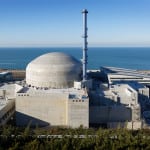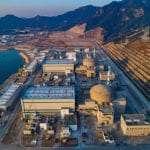EDF’s board of directors made a final investment decision on July 28, giving the go-ahead to construct two nuclear reactors at Hinkley Point C in Somerset, England.
The decision means the company can move forward with the long-anticipated project. Several contracts will need to be executed, including with the British government, China General Nuclear Power Generation (EDF’s partner on the project), and several other suppliers.
In a press release announcing the decision, EDF said Hinkley Point C is a major element of the company’s “CAP 2030” strategy. The strategy consists of three main priorities, one of which includes developing new nuclear power plants.
EDF said constructing two EPR-style reactors—an AREVA design—at Hinkley Point would strengthen its presence in Britain. Its subsidiary, EDF Energy, already operates 15 nuclear reactors in the country, and it is the largest electricity supplier by volume.
The first concrete for Reactor 1 is scheduled for mid-2019. EDF said the timing coincides perfectly with the startup of another EPR it has under construction at Flamanville in northern France. The first concrete for that unit was poured in 2007. Flamanville is currently six years behind schedule, and its costs have more than tripled from original estimates, which has many in the UK worried that a similar fate could befall Hinkley Point.
There are no EPRs in commercial operation yet. The Olkiluoto 3 EPR, under construction in Finland, has also been beset by schedule delays and cost overruns. Teollisuuden Voima Oyj (TVO)—owner and operator of the Olkiluoto facility—and the AREVA-Siemens construction consortium have had an arbitration case before the International Chamber of Commerce since December 2008 attempting to resolve responsibility for the cost overruns.
Two EPR units under construction in China are also behind schedule.
But costs and schedule delays have not been the EPR’s only problems. In April 2015, AREVA admitted that high-carbon concentration had been identified in the steel of a reactor vessel head and bottom similar to Flamanville’s, causing the material’s mechanical toughness to be questioned. Additional audits revealed “irregularities in the manufacturing checks” on about 400 parts produced since 1965 at AREVA’s Creusot steel forging plant, which further tarnished the company’s image.
Nonetheless, EDF is sticking with the EPR design. The company said Hinkley Point C “is a unique asset for French and British industries as it will benefit the whole of the nuclear sectors in both countries and will support employment at major companies and smaller enterprises in the industry.”
EDF’s Board of Directors gives approval for #Hinkley Point investment https://t.co/cVz2VuhCbS pic.twitter.com/DN3MC37i4v
— EDF Energy Comms (@edfenergycomms) July 28, 2016
—Aaron Larson, associate editor (@AaronL_Power, @POWERmagazine)










